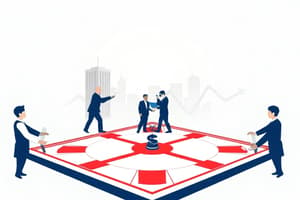Podcast
Questions and Answers
What is the maximum duration of a pharmaceutical patent?
What is the maximum duration of a pharmaceutical patent?
- 20 years (correct)
- 15 years
- 25 years
- 10 years
What typically happens to drug prices when they go off patent?
What typically happens to drug prices when they go off patent?
- Generic equivalents appear quickly (correct)
- Prices increase significantly
- FDA approval is no longer required
- Pharmaceutical companies continue to hold monopolies
What was the Ansari X Prize awarded for?
What was the Ansari X Prize awarded for?
- Developing a new video game
- Innovating lightbulb technology
- Creating a manned rocket (correct)
- Improving drug research
What is a common method to incentivize research and development mentioned in the content?
What is a common method to incentivize research and development mentioned in the content?
Which of the following is true regarding the costs of pharmaceuticals and video games?
Which of the following is true regarding the costs of pharmaceuticals and video games?
What impact does reducing prices on pharmaceuticals or video games have according to the content?
What impact does reducing prices on pharmaceuticals or video games have according to the content?
How much did Netflix offer as a prize for improving its movie recommendation system?
How much did Netflix offer as a prize for improving its movie recommendation system?
What is the typical development cost range for video games mentioned in the content?
What is the typical development cost range for video games mentioned in the content?
What happens to consumer surplus when a market shifts from competition to monopoly?
What happens to consumer surplus when a market shifts from competition to monopoly?
What is indicated by the area labeled as 'deadweight loss' in a monopoly?
What is indicated by the area labeled as 'deadweight loss' in a monopoly?
How does the price under monopoly compare to the competitive price?
How does the price under monopoly compare to the competitive price?
What is the monopolist's marginal cost equal to at the profit-maximizing quantity?
What is the monopolist's marginal cost equal to at the profit-maximizing quantity?
What is the primary reason monopolies do not maximize total surplus?
What is the primary reason monopolies do not maximize total surplus?
In a competitive market, how do prices generally relate to marginal cost?
In a competitive market, how do prices generally relate to marginal cost?
What term refers to the extra profit that monopolists earn due to reduced competition?
What term refers to the extra profit that monopolists earn due to reduced competition?
What would likely occur if a monopoly were to perfectly price discriminate?
What would likely occur if a monopoly were to perfectly price discriminate?
What is emphasized in modern theories of economic growth regarding monopoly?
What is emphasized in modern theories of economic growth regarding monopoly?
What role do patent laws play according to Douglass North?
What role do patent laws play according to Douglass North?
What is a consequence of not having systematic property rights in innovation mentioned in the content?
What is a consequence of not having systematic property rights in innovation mentioned in the content?
What is the potential benefit of patent buyouts as proposed by economist Michael Kremer?
What is the potential benefit of patent buyouts as proposed by economist Michael Kremer?
How does the trade-off between lower prices and future game innovation relate to economic principles?
How does the trade-off between lower prices and future game innovation relate to economic principles?
What does the green profit rectangle in Figure 13.3 represent?
What does the green profit rectangle in Figure 13.3 represent?
Which statement best summarizes the historical development of technological innovations?
Which statement best summarizes the historical development of technological innovations?
What is a significant consequence of copying innovations at no cost mentioned in the content?
What is a significant consequence of copying innovations at no cost mentioned in the content?
What is a significant consequence of a monopolized economy?
What is a significant consequence of a monopolized economy?
Why are business leaders in the United States viewed positively compared to political leaders in Algeria?
Why are business leaders in the United States viewed positively compared to political leaders in Algeria?
Which option describes a potential benefit of monopolies in the pharmaceutical industry?
Which option describes a potential benefit of monopolies in the pharmaceutical industry?
What could be a consequence of enforcing strong patent protection on drug prices?
What could be a consequence of enforcing strong patent protection on drug prices?
How much does it cost, on average, to research and develop a new drug in the United States?
How much does it cost, on average, to research and develop a new drug in the United States?
What is a common policy among some countries to control pharmaceutical prices?
What is a common policy among some countries to control pharmaceutical prices?
What is the effect of competition on pharmaceutical prices, as illustrated by GlaxoSmithKline's pricing strategy?
What is the effect of competition on pharmaceutical prices, as illustrated by GlaxoSmithKline's pricing strategy?
What myth about business leaders in the U.S. is dispelled in the discussion of monopolies?
What myth about business leaders in the U.S. is dispelled in the discussion of monopolies?
What was the average price of electricity per megawatt hour (MWh) in April 2000?
What was the average price of electricity per megawatt hour (MWh) in April 2000?
What peak price did electricity reach in December 2000?
What peak price did electricity reach in December 2000?
Which factor contributed to the increased demand for electricity in California during the summer of 2000?
Which factor contributed to the increased demand for electricity in California during the summer of 2000?
What caused the supply of hydroelectric power to fall by approximately 20%?
What caused the supply of hydroelectric power to fall by approximately 20%?
What event affected more than 1 million Californians due to electricity supply issues?
What event affected more than 1 million Californians due to electricity supply issues?
How did generators of electricity exploit market power when demand was high?
How did generators of electricity exploit market power when demand was high?
What type of demand did each generator face in 1999 due to abundant supply?
What type of demand did each generator face in 1999 due to abundant supply?
What problem can occur if demand and supply of electricity are out of equilibrium?
What problem can occur if demand and supply of electricity are out of equilibrium?
What does a monopolist's price typically exceed?
What does a monopolist's price typically exceed?
Which aspect is NOT mentioned as a trade-off involved with monopolies?
Which aspect is NOT mentioned as a trade-off involved with monopolies?
How does a natural monopoly typically relate to economies of scale?
How does a natural monopoly typically relate to economies of scale?
What was one outcome of regulating cable TV prices?
What was one outcome of regulating cable TV prices?
What can be a consequence of having patent monopolies, such as on Combivir?
What can be a consequence of having patent monopolies, such as on Combivir?
What effect did deregulation have on cable television rates?
What effect did deregulation have on cable television rates?
What is a potential negative consequence of electricity deregulation mentioned?
What is a potential negative consequence of electricity deregulation mentioned?
Which factor influences the markup of price over marginal cost in monopoly theory?
Which factor influences the markup of price over marginal cost in monopoly theory?
Flashcards
Quantity difference (Qc - Qm)
Quantity difference (Qc - Qm)
The difference between the quantity produced in a competitive market (Qc) and the quantity produced by a monopolist (Qm).
Total surplus
Total surplus
The area between the demand curve and the marginal cost curve, representing the total value consumers place on a good.
Deadweight loss (DWL)
Deadweight loss (DWL)
The loss in total surplus that occurs when a monopolist restricts output and charges a higher price.
Marginal cost (MC)
Marginal cost (MC)
Signup and view all the flashcards
Marginal utility
Marginal utility
Signup and view all the flashcards
Monopoly
Monopoly
Signup and view all the flashcards
Perfect competition
Perfect competition
Signup and view all the flashcards
Producer surplus
Producer surplus
Signup and view all the flashcards
Marginal cost
Marginal cost
Signup and view all the flashcards
Deadweight loss
Deadweight loss
Signup and view all the flashcards
Patent
Patent
Signup and view all the flashcards
Quantity Difference
Quantity Difference
Signup and view all the flashcards
Marginal Revenue (MR)
Marginal Revenue (MR)
Signup and view all the flashcards
Markup
Markup
Signup and view all the flashcards
Natural Monopoly
Natural Monopoly
Signup and view all the flashcards
Regulation
Regulation
Signup and view all the flashcards
Innovation Trade-off
Innovation Trade-off
Signup and view all the flashcards
Study Notes
Monopoly
- Definition: A firm with market power, able to raise prices above marginal cost without fear of new competitors entering the market.
Market Power
- Source: Patents, government regulations, economies of scale, exclusive access to an input, and technological innovation can all lead to market power.
Profit Maximization
- Principle: Produce until marginal revenue (MR) equals marginal cost (MC).
- Considerations: A firm with substantial market share will see its output significantly impact market price, so MR will be less than price.
Elasticity of Demand
- Inelastic demand: The more inelastic the demand curve, the greater the monopolist's ability to raise price above marginal cost. This is particularly true when there are few substitutes for the product (e.g., life-saving medication).
Costs of Monopoly
- Deadweight loss: Loss of total surplus because less output is produced by a monopolist than a competitive industry—some consumers are excluded from the market, though they would pay more than the marginal cost of production.
- Corruption: In some cases, monopolies are created or maintained through corruption. A firm or controlling party may not be producing at a competitive level due to political or similar reasons.
Economies of Scale
- Natural monopolies: When a single firm can serve the entire market at lower cost than multiple firms, this is a natural monopoly. Examples are water distribution systems, electricity grids, and transportation networks.
Regulation
- Government intervention: Governments may regulate monopolies to control price gouging and ensure sufficient output. Price regulation at a level below the profit-maximizing price may increase output. But regulation can reduce incentives for innovative work.
Case Study: Pharmaceuticals
- Patents and pricing: The high costs of research and development (R&D) for new pharmaceuticals are often a justification for the high prices and temporary monopolies granted through patents.
- Incentives for R&D: The ability for a pharmaceutical company to maintain a positive markup above production costs is an incentive for continuing the expensive process of developing new drugs.
- Role of government: Regulations, such as patent protections, can encourage or dampen innovation in the pharmaceuticals space.
Case Study: Cable TV
- Deregulation and Price: Deregulation of cable TV led to increased prices but also led to a broader array of channels. Customers benefitted, but this example illustrates the complexities of regulating or deregulating monopolies.
Case Study: Electricity
- Government regulation: Government oversight of electricity generation, transmission, and distribution has been a common practice. In the 1990s-2000s California's deregulation led to significant price increases followed by system instability.
- Economies of scale and price: The cost curve of a single producer supplying a city with electricity may be significantly lower compared to that for many producers using smaller plants. Even in a deregulated market, supply and demand issues are an important consideration.
Studying That Suits You
Use AI to generate personalized quizzes and flashcards to suit your learning preferences.




